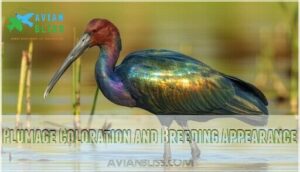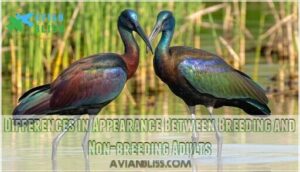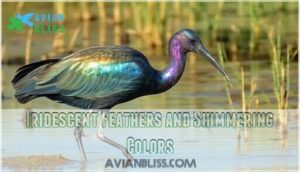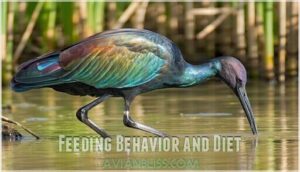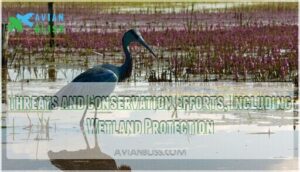This site is supported by our readers. We may earn a commission, at no cost to you, if you purchase through links.
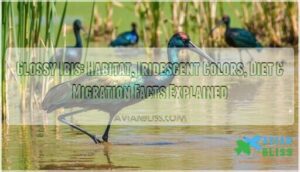 You’ll find the glossy ibis wading through wetlands worldwide, from North America to Australia.
You’ll find the glossy ibis wading through wetlands worldwide, from North America to Australia.
This medium-sized bird catches your eye with its dark bronze and green iridescent feathers that shimmer like oil on water.
During breeding season, it develops striking copper-red plumage around the head and neck.
The glossy ibis uses its long, curved bill to probe muddy waters for aquatic insects, crustaceans, and small fish.
It’s a social bird that nests in colonies, often alongside herons and egrets.
With expanding populations and adaptable nature, this wetland wanderer continues to colonize new territories across six continents, making it one of the world’s most widespread ibis species.
Table Of Contents
- Key Takeaways
- Glossy Ibis Habitat
- Physical Characteristics
- Breeding and Life Cycle
- Feeding Behavior and Diet
- Conservation Status and Migration
- Frequently Asked Questions (FAQs)
- Where do glossy ibis live?
- What does a glossy ibis look like?
- What does a glossy ibis symbolize?
- Are glossy ibis quiet?
- What do you do with a glossy ibis?
- What does a white ibis look like?
- Where do you find glossy ibis?
- Are glossy ibis native to Florida?
- Is glossy ibis endangered?
- What does a glossy ibis eat?
- Conclusion
Key Takeaways
- You’ll spot glossy ibis by their dark bronze and green iridescent feathers that shimmer like oil on water, with striking copper-red plumage developing around the head and neck during breeding season.
- You’ll find these adaptable wading birds thriving in both freshwater and saltwater wetlands across six continents, where they use their long, curved bills to probe muddy waters for aquatic insects, crustaceans, and small fish.
- You’ll observe their remarkable nomadic behavior as they expand their range globally – some tagged chicks have traveled 6,000 kilometers from Spain to the Caribbean, making them one of the world’s most widespread ibis species.
- You’ll discover they’re social birds that nest in colonies alongside herons and egrets, with stable "Least Concern" conservation status despite facing threats from habitat loss and climate change affecting their wetland homes.
Glossy Ibis Habitat
You’ll find glossy ibises living in freshwater and saltwater wetlands, including marshes, mudflats, and flooded fields.
Their habitats stretch across six continents, with populations favoring areas rich in shallow water and dense vegetation.
Freshwater and Saltwater Wetlands
Step into the domain of glossy ibis and you’ll see their love for wetland habitat. They thrive in freshwater wetlands and saltwater wetlands, depending on Wetland Salinity and Water Quality.
Shallow marshes and Coastal Wetlands offer prime bird habitat. Vegetation and shelter is also essential for these birds, offering protection and nesting sites.
Wetland Restoration helps fight Habitat Degradation, keeping these areas healthy for ibis. The following are key types of wetlands:
- Freshwater wetlands
- Saltwater wetlands
- Shallow marshes
- Coastal wetlands
- Wetland restoration is crucial for maintaining these ecosystems, which provide prime bird habitat.
Range Expansion and Nomadic Behavior
Beyond their wetland homes, you’ll find glossy ibis are true nomads.
These birds exhibit remarkable range expansion driven by climate change and habitat availability. Their dispersal mechanisms allow incredible journeys—some tagged chicks traveled 6,000 kilometers from Spain to the Caribbean!
From Spain to the Caribbean in a single flight – glossy ibis chicks prove distance means nothing to wanderers.
This nomadic behavior enhances genetic diversity across populations.
As a colonizing breeder, the Glossy Ibis is showing increasing presence in the UK.
| Expansion Factor | Impact on Bird Distribution |
|---|---|
| Climate Events | Droughts trigger mass emigration and new colony formation |
| Resource Tracking | Birds follow seasonal food availability across continents |
| Migration Patterns | First-year birds show highest dispersal rates (73.5%) |
Wetland Conservation Areas
You’ll find glossy ibis thriving in wetland conservation areas where habitat restoration efforts have improved water quality and species diversity.
These protected spaces offer essential refuges as climate change threatens traditional wetland habitats.
Bird conservation programs in these areas boost public awareness while supporting diverse bird species through enhanced wetland habitats designed specifically for bird conservation needs, which ultimately contributes to overall wetland habitats.
Physical Characteristics
You’ll notice a glossy ibis by its striking iridescent plumage that shimmers with metallic greens, purples, and bronzes during breeding season.
The bird’s appearance changes dramatically throughout the year, with rich chestnut bodies and vibrant wing colors in breeding adults that fade to duller brown tones when not breeding, showcasing a notable change in its overall plumage.
Plumage Coloration and Breeding Appearance
You’ll notice a glossy ibis transforms dramatically during breeding season.
During breeding season, this stunning bird transforms into a living jewel with shimmering metallic colors.
The breeding adult develops rich chestnut bodies with metallic green wings that shimmer with purple and bronze hues.
This iridescent plumage creates stunning color changes as light hits the feathers.
Juveniles display duller brown tones with white neck streaking, while facial skin darkens in breeding adults compared to nonbreeding adult birds, showcasing a notable color change.
Differences in Appearance Between Breeding and Non-breeding Adults
You’ll notice the Glossy Ibis transforms dramatically between seasons.
Breeding adults showcase vibrant metallic shades with distinctive pale eye lines around dark facial skin. Their plumage changes reveal rich purples, greens, and bronzes.
Nonbreeding adults lose these striking eye lines and display much duller color vibrancy. The bird’s color pattern shifts from brilliant iridescence to subdued browns, making seasonal identification straightforward for birdwatchers with vibrant displays.
Iridescent Feathers and Shimmering Colors
You’ll discover the glossy ibis’s most striking feature in its plumage iridescence.
Feather structure creates stunning metallic shades through light reflection off microscopic platelets.
These iridescent feathers shimmer with purple, green, and bronze hues in sunlight.
The bird color pattern serves visual signaling for mate attraction, while specialized keratin layers produce this remarkable bird plumage display.
They often forage in shallow saltwater wetlands.
Breeding and Life Cycle
You’ll find glossy ibis breed in colonies that offer protection from predators through group vigilance and shared nesting areas.
Their breeding cycle spans from spring through late summer, with both parents sharing duties from nest construction to feeding their young for several weeks after hatching, utilizing shared nesting areas.
Colonial Nesting and Predator Protection
You’ll find glossy ibises thriving in large breeding colonies that can house hundreds of pairs.
These birds choose nest sites strategically, often mixing with herons and egrets for enhanced predator protection.
Colony size dynamics create a safety-in-numbers effect, where cooperative defense mechanisms dramatically boost chick survival rates.
Nesting synchronicity guarantees most eggs hatch simultaneously, overwhelming potential threats and maximizing breeding success.
Foraging and Nesting Habits
You’ll spot glossy ibises using smart prey selection strategies, probing muddy substrates with their curved bills to find invertebrates.
Their bird foraging behavior involves sweeping motions through shallow water.
During breeding season, both sexes tackle nest building together in colonies. Males gather sticks while females construct platforms.
Colony dynamics keep families close, with nests just two feet apart for protection. To acquire suitable nesting materials, they often rely on specific resources.
- Tactile hunting: Bills detect buried prey through touch rather than sight
- Coordinated foraging: Flocks move together, stirring up invertebrates for easier capture
- Strategic nest placement: Colonies balance safety from predators with access to rich feeding grounds
- Material teamwork: Males collect building supplies while females focus on construction techniques
- Flexible timing: Nest building coincides with peak food availability during wet seasons
Incubation and Fledgling Period
Once you’ve watched glossy ibis pairs settle into their nesting routine, you’ll witness the remarkable incubation period unfold.
Both breeding adult birds share egg-warming duties for twenty-one days, keeping their pale blue-green treasures safe. After hatching, parental regurgitation feeds hungry chicks while nestling development accelerates rapidly through fledgling independence.
Nesting site optimization balances safety with access to food, essential for chick survival.
| Development Stage | Timeline | Key Features |
|---|---|---|
| Egg Coloration | Day 1 | Pale blue-green eggs |
| Incubation Period | 21 days | Both parents alternate |
| Nestling Development | 2-3 weeks | Parental regurgitation feeding |
| Fledgling Independence | 6-7 weeks | Juvenile foraging begins |
Feeding Behavior and Diet
You’ll find glossy ibis wading through shallow waters with their curved bills, methodically probing mud to capture small aquatic creatures.
Their diet consists mainly of invertebrates like worms, crustaceans, and insects, though they’ll also take small fish and amphibians when available, which can be considered small aquatic creatures, and their feeding behavior is focused on invertebrates.
Foraging Techniques and Prey Capture
You’ll find glossy ibis using their remarkable bill sensitivity to locate hidden prey beneath murky waters.
Their curved bills work like underwater metal detectors, probing soft mud with precision.
Foraging Techniques:
- Mud Probing – Bills sweep side-to-side through sediment layers
- Prey Identification – Sensitive nerve endings detect movement instantly
- Cooperative Foraging – Groups work together in shallow feeding areas
- Diet Adaptations – Flexible hunting matches seasonal food availability
- Tactile Hunting – Feel replaces sight in cloudy water conditions
Aquatic Invertebrates and Small Animals
While probing soft mud and shallow waters, you’ll see glossy ibises target specific prey based on Bill Sensitivity and availability.
Their diet includes crayfish, worms, beetles, and small fish.
Invertebrate Abundance drives their Prey Selection, with Foraging Efficiency depending on habitat conditions.
| Primary Prey | Hunting Method |
|---|---|
| Crayfish & aquatic invertebrates | Tactile probing in mud |
| Small fish & frogs | Visual detection in shallow water |
| Beetles & worms | Sensitive bill exploration |
Diet Variations and Seasonal Changes
You’ll notice glossy ibis change their menu throughout the year based on prey availability.
During breeding season, these birds focus on protein-rich aquatic invertebrates like crayfish and insects to fuel egg production.
Winter diet shifts toward whatever’s accessible – earthworms, beetles, and small fish become staples.
Juvenile diet consists mainly of soft insects for easier digestion, while adults show more flexibility in their seasonal foraging patterns.
They’re considered water-based feeders, showcasing adaptability and being water-based feeders.
Conservation Status and Migration
You’ll find that glossy ibises maintain a "Least Concern" conservation status globally, with populations actually expanding in many regions since the 1960s.
These adaptable birds showcase fascinating migration patterns that vary by location – some populations migrate seasonally while others remain year-round residents or move nomadically following rainfall and food availability, which is a key factor in their conservation status.
Low Concern Conservation Status and Population Growth
The glossy ibis enjoys a "Least Concern" IUCN Status, reflecting remarkable Population Resilience across global ranges.
Their conservation status stems from impressive Habitat Adaptability, allowing populations to thrive in diverse wetlands.
Breeding Success rates remain consistently high, while Range Dynamics show continued expansion into new territories.
This Conservation Paradox demonstrates how adaptable species can flourish despite environmental pressures, with population trends indicating steady growth rather than decline.
Threats and Conservation Efforts, Including Wetland Protection
Despite their stable population, glossy ibis face mounting challenges.
Habitat loss from wetland drainage threatens breeding grounds, while pollution impacts and climate change driven threats alter water levels and food availability.
Invasive species disrupt ecosystems, and human disturbance reduces nesting success.
Conservation strategies focus on wetland protection, establishing reserves, and monitoring programs to safeguard colonies.
Supplementing their diet can be achieved with specialized bird feeders.
Seasonal Movements and Migratory Behavior
Migration triggers like changing daylight hours and temperature shifts guide glossy ibis along established flyway routes.
These migratory birds travel between breeding areas and wintering grounds, with North American populations heading to Central America.
Climate change disrupts traditional dispersal patterns, forcing birds to adapt their seasonal movements and timing.
Similarly, the American Kestrel also exhibits latitudinal migration patterns, which is a clear example of latitudinal migration and the impact of climate change on bird movements.
Frequently Asked Questions (FAQs)
Where do glossy ibis live?
You’ll find these wading birds thriving in freshwater marshes, saltwater wetlands, swamps, and flooded fields across six continents. They prefer shallow waters with mudflats for feeding and nesting.
What does a glossy ibis look like?
Like a sleek, dark arrow cutting through marsh grasses, you’ll spot this medium-sized wading bird with its long, curved bill and iridescent bronze-green plumage that shimmers beautifully in sunlight.
What does a glossy ibis symbolize?
You’ll find symbolic meanings tied to wisdom, transformation, and spiritual guidance. Ancient cultures viewed these birds as messengers between earthly and divine domains, representing adaptability and renewal.
Are glossy ibis quiet?
Silent as morning mist, these wading birds aren’t particularly quiet.
You’ll hear their soft grunts and croaks during feeding and flight, plus louder calls during breeding season when they’re establishing territories and communicating with mates, which can be considered soft and include louder calls.
What do you do with a glossy ibis?
You observe, photograph, and study these wetland birds from a respectful distance. Don’t disturb their feeding or nesting areas. Support habitat conservation efforts to protect their marshes and breeding colonies.
What does a white ibis look like?
You’ll spot a white ibis by its bright white plumage, long pink legs, and distinctive curved pink bill.
During breeding season, they develop black wingtips that contrast beautifully against their snowy feathers.
Where do you find glossy ibis?
You’ll find these birds in freshwater marshes, saltwater wetlands, mudflats, flooded fields, and mangroves across six continents. They prefer shallow waters with muddy bottoms for foraging opportunities.
Are glossy ibis native to Florida?
No, these wandering waders aren’t Florida natives! You’ll discover glossy ibis actually colonized North America naturally from Africa, establishing themselves as year-round residents along Florida’s coastline.
Is glossy ibis endangered?
This species isn’t endangered. The glossy ibis has an IUCN status of "Least Concern," though you’ll find they face habitat threats from wetland loss and human disturbance affecting local populations.
What does a glossy ibis eat?
You’ll discover their menu isn’t picky—glossy ibis probe muddy shallows with curved bills, snatching up aquatic invertebrates, small fish, frogs, and occasional crustaceans like nature’s flexible dining utensils.
Conclusion
Like a shimmering jewel adorning nature’s wetland tapestry, the glossy ibis stands as one of our planet’s most adaptable wading birds.
You’ve discovered a remarkable species that thrives across six continents through its flexible diet and habitat choices.
The glossy ibis continues expanding its range while maintaining stable populations.
Its iridescent plumage and social nesting behaviors make it a fascinating subject for birdwatchers.
By protecting wetland habitats, you’re supporting this resilient species and countless other wildlife that depend on these critical ecosystems.

